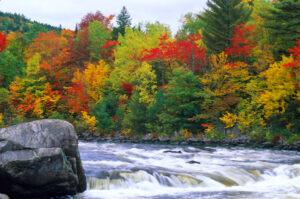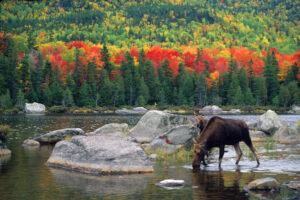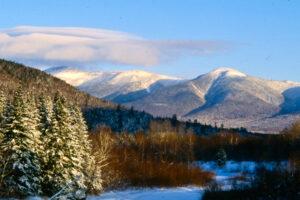Recently, Maine’s U.S. Senators Angus King and Susan Collins introduced legislation in Congress to authorize the expansion of the Katahdin Woods and Waters National Monument in Maine. The bill would permit the acquisition of up to 43,000 acres of land between the town of Millinocket and the current southern border of the monument.
The 87,500-acre monument lies east of Baxter State Park. Combined with the 210,000-acre state park, the 46,270-acre Debsconeag Lakes Wilderness Area owned by The Nature Conservancy and the Appalachian Mountain Club’s 102,000-acre Maine Woods Initiative, the area is the largest tract of protected wildlands in the state.
The support for enlarging Katahdin Woods and Waters National Monument by both Senators provides a lesson in conservation history that I’ve seen repeatedly. Both Senators initially opposed the proposal for a unit of the National Park System in the Maine Woods. They wrote a letter to President Obama outlining “serious reservations.” However, to their credit they are now supporters of the monument.
Even though there is often strong local opposition to new parks, wilderness or other public lands designations, over time people generally see the benefits of public lands and special protection and come to support it.
In an article I wrote for Sierra Magazine, I detailed how local opposition to parks, monuments, and other protective designations has nearly always turned into local support.
For instance, when Grand Teton National Park was being proposed, locals in Jackson, Wyoming, opposed the park, suggesting that Jackson would become a “ghost town” if the park were established. Anyone who has visited Jackson, Wyoming lately knows it is anything but a ghost town.
When RESTORE the North Woods first proposed creating a national park and preserve in the Maine Woods in 1994, there was almost universal opposition to the idea. Both of these Senators voiced their opposition (King was elected governor of Maine that year), as well as nearly all “conservation groups” in the state. Local opposition in Millinocket, the principal gateway community, and the rest of Northern Maine, was almost unanimous.
What happened to change the opposition to reluctant support to full embracement of the park is a tale worth telling.
BEGINNINGS
The idea for a preserve in Maine Woods has a long history. Henry David Thoreau made three trips to the Maine Woods in the 1840-50s. He suggested that its wildlands, especially the area surrounding Katahdin, Maine’s greatest mountain, should be protected as a “national preserve.”
On and off discussions for some kind of parkland occurred throughout the ensuing decades. There was even a proposal to create a million-acre national park focused on Katahdin in the 1930s.
Part of the problem, however, was that unlike the western United States, where there were extensive areas of public land, almost all of northern Maine was then owned by forestry companies and timber barons. Thus, creating a park would require a substantial investment in land acquisition.
By the 1920s, efforts to protect Maine’s highest peak as a park intensified. Maine’s Governor, Percival Baxter, advocated the creation of a state park focused on Katahdin. But the Maine legislature, heavily influenced by timber interests, refused to go along. In the end, Baxter decided he would buy the land himself and donate it to the state for a park.
Fast forward to the late 1980s. I was working on several books about New England, including one on Vermont and another on Maine. During my research, I discovered that several large areas of Vermont in what is known as the Northeast Kingdom, as well as in Maine surrounding Katahdin, had previously been considered for acquisition as national parks or national forests.
When I contacted conservation groups in the region, I asked if anyone was proposing new public land acquisitions. I was told that people in New England didn’t support new public lands, especially any controlled by the federal government.
I found that answer unacceptable. So, both in my books, and by writing supportive letters to the editor and other media, I began to promote the idea of new national parks for the region. I identified the Nulgehan Basin of Vermont’s Northeast Kingdom as a potential area for land acquisition and the creation of a Northeast Kingdom National Park or some other federal holding. I also pointed out that a similar situation existed in Maine, with huge acreage of forested lands owned by timber companies that could be acquired for a park.
In addition, I wrote letters and commentaries to local papers and for regional newsletters arguing that parks should be created. I wrote Congressional representatives asking for them to consider new land acquisitions for parks, and so on.
This provoked opposition from local residents. But at least there was some public discussion.
Then in 1988, the editor of Wilderness Magazine, T. H. Watkins, contacted me. He had seen some of my letters and articles. He asked me to write a piece for the magazine.

Autumn along the West Branch Penoscot River by Big A Falls, Maine. Photo George Wuerthner.
During my research for the article, called Northeast Kingdoms: Is it time to rescue the last of New England’s Wilderness?, Watkins put me in contact with the Wilderness Society’s New England Representative, Michael Kellett. Kellett and I hit it off immediately. We both had a similar passion for wildlands and national parks.
In March, 1989, The Wilderness Society unveiled the organization’s proposal for “A New Maine Woods Reserve” (Kellett, 1989). The proposal called for acquisition and protection of an area with roughly the same location and configuration as the “Maine Woods National Park” concept described in my 1988 article.
The reason for promoting a large national park had to do with the limited public land ownership in the state. Only about 5% of Maine’s land area was publicly owned, one of the lowest proportions of any U.S. state. The vast majority was owned by a handful of large timber companies and investors.
Shortly after our meeting, Michael Kellett decided to focus his efforts on creating a 3.2 million acre Maine Woods National Park. With the help of another New England conservationist, David Carle, we created RESTORE: The North Woods in 1992 to promote the idea. I have served on RESTORE’s board ever since. Soon after, wildlands advocate Jym St. Pierre joined the RESTORE staff as Maine Director, a position he still holds.
Our plan was not entirely new. We followed in the footsteps of a New Hampshire wildlands activist, Jamie Sayen, who had previously published a proposal for a “Preserve Appalachian Wilderness” system in 1987. Sayen later joined the RESTORE board.
Meanwhile, we got a breakthrough when U.S. Senator Patrick Leahy of Vermont wrote me to say he liked the idea of a Northeast Kingdom National Park or some other new public lands acquisition in Vermont. Leahy eventually got funding for a Northern Forest Lands Study that included lands from upstate New York to Maine, which, among other things, identified threats to these lands and proposed new conservation initiatives.
A review of the timber industry in Maine demonstrated that in many instances, rather than invest in the modernization of mills, the industry trend was to sell its holdings and reinvest in the South where the climate was more favorable for tree growth, and labor laws were more favorable to industry. During the 1980s, 1990s and 2000s, millions of acres of the Maine Woods were sold, often to investors or other timber interests.
For instance, in 1998, Sappi sold 905,000 acres to Plum Creek Timber Company. This trend has continued until today. Meanwhile, from 1980 to 2016, two-thirds of Maine’s remaining 25 pulp and paper mills were shuttered, others were struggling, thousands of mill and woods workers lost their jobs, and mill towns were devastated. Today, fewer than 10 paper mills are operating in the state.
Several recent books document the demise of Maine’s forest industry, including Shredding Paper by Michael Hillard, Haywire by Andrew Egan and Mill Town by Kerri Arsenault.
The situation in Maine was unique. Most of the private property in northern Maine was owned by the timber industry or investors. So, as with the Sappi sale, it was possible to acquire a large piece of property by dealing with a handful of property owners. Had the federal government been prepared to buy the Sappi lands, it could have created the second largest national park in the entire eastern United States (after the Everglades).

Much of northern Maine is part of the Unorganized Townships with more moose than permanent human residents. Photo George Wuerthner
Another unusual feature of northern Maine is “unorganized townships,” which cover half the acreage in the state. Most have no permanent residents, though there are scattered camps. No one would have to move from these lands to create a large national park. Existing camps could be grandfathered.
Recognizing the opportunity this created for public acquisition, RESTORE began to lobby for public land purchases within the boundary of our proposal. Such legislation would authorize the federal government to buy from willing sellers any property that came up for sale there.
The same process has been used to create other national parks, national wildlife refuges and national forests in the eastern United States, including Great Smoky Mountains National Park, White Mountain National Forest and Silvio O. Conte National Fish and Wildlife Refuge.
The 39,500-acre Silvio O. Conte NWR acquisition was a direct result of the debate that was started over a national park in the Northeast Kingdom, and later the Northern Forest Land Study, which identified the Nulhegan Basin as critical wildlife habitat.
At the same time, various groups and agencies acquired more lands in the Maine Woods, including the Appalachian Mountain Club, The Nature Conservancy, the State of Maine and others. Meanwhile RESTORE continued to advocate for a major national park unit in the Maine Woods.
ROXANNE QUIMBY
For years, RESTORE had a table at the annual Maine Common Ground Fair where we advocated for our park proposal. One day a woman stopped by and chatted with RESTORE’s staff. That woman was Roxanne Quimby who at the time owned the natural skin care company Burt’s Bees. Quimby had started her business in Maine. Her kids had hiked the entire Appalachian Trail, including the Hundred Mile Wilderness, which was within our park proposal. She was intrigued by the idea of a Maine Woods National Park.
After further conversations between RESTORE staff and Quimby, she began purchasing lands that ultimately she hoped to donate to the people of the United States as a new national park unit. The opportunity for such a donation came after President Barrack Obama was elected. By then, many conservation groups and others were supportive. Using the authority of the Antiquities Act Obama accepted Quimby’s land donation and created Katahdin Woods and Water National Monument in 2016.
LESSONS LEARNED
Forward to the announcement last month that US. Senators King and Collins are sponsoring legislation to allow the expansion of Katahdin Woods and Water National Monument. Local people have come to accept and, in many cases, enthusiastically support a national park unit in the Maine Woods, I have no doubt that over time it will be expanded further.
Most importantly, conservation takes years, sometimes decades, to implement. RESTORE began its advocacy in the 1990s and we are still working to implement our vision for a 3.2-million-acre national park in Maine, as well as advocating for new national parks elsewhere through our New National Parks campaign.

The White Mountains of New Hampshire are one of RESTORE’s proposed parks in our New National Parks Campaign. Photo George Wuerthner.
Grand Teton National Park was first authorized as a national park in the 1920s, but the park’s creation in its current form did not occur until 1950. The same for parks now covering the Brooks Range in Alaska. In the 1930s, wilderness proponent Bob Marshall advocated that everything north of the Yukon River should be set aside as a giant national park. In the 1960s, the Arctic Wildlife Refuge was established. In the 1980s, the Alaska National Interest Lands Conservation Act put much of the land north of the Yukon River into federally protected status. This includes the Gates of the Arctic NP, Kobuk Valley NP, Noatak Preserve, Koyukuk NWR, Yukon Flats NWR, Selawik NWR, and a significant expansion of the Arctic NWR, plus numerous Wild and Scenic River designations.
The other lesson is that the stars must line up. Often a proposal will simmer for years, then suddenly, the right circumstances permit it to be realized. To borrow a quote from RESTORE board member and long-time conservation advocate Brock Evans, it takes endless pressure, endlessly applied.
Finally to all of you with your own ideas and proposals. Do not become discouraged if you first do not succeed. Think Big. Stay true to your vision. You never know when and how it might be realized.
As the Poet Gary Synder wrote:
The rising hills, the slopes,
of statistics
lie before us.
the steep climb
of everything, going up,
up, as we all
go down.In the next century
or the one beyond that,
they say,
are valleys, pastures,
we can meet there in peace
if we make it.To climb these coming crests
one word to you, to
you and your children:stay together
learn the flowers
go light